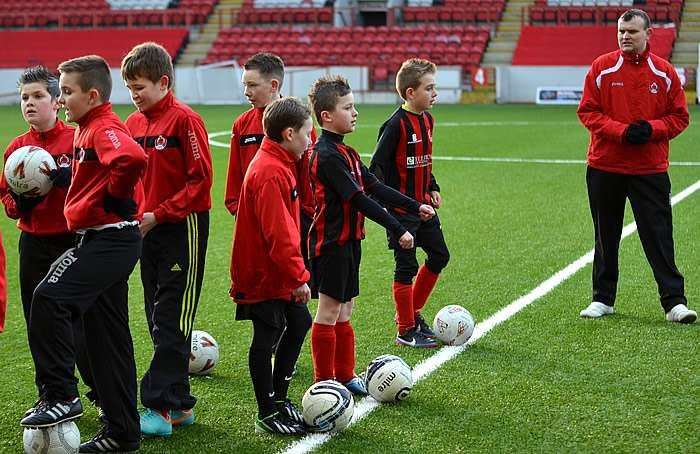
The curious case of youth academies
There are a few things in the universe that money can’t buy, and in the world of competitive football, childhood and talent aren't included on that list. Football clubs have recently initiated an insatiable appetite of haggling young talents in an attempt to win a competition that is rather passive aggressive in nature – the race to accumulate childhood prodigies in youth academies.
Transfer fees and purchasing prices are soaring as adolescent and teenage international youth are being signed for clubs all over the world. Eminent clubs including Real Madrid and Barcelona are alleged to have breached restrictions put in place by FIFA, resulting in thunderous sanctions pouring down on them.
A staggering fine of a hundrend thousand pounds has been most recently imposed on Liverpool, accompanied by a two year ban on signing youth academy players – all for a 12 year old from Stoke City.
Barcelona have already served a year of restrictions on signing talents in the transfer market. To top that, in 2016, both Real Madrid and rivals Atletico Madrid allegedly breached rules protecting young players, following which both teams lost appeals to sign young talents until 2018.
Severe restrictions on transfer activity can seriously limit a club’s ability to sign international youth. According to FIFA’s findings, China’s Wanda Group has set off a stream of youngsters, travelling by trains that take them to youth academies run by top-notch clubs all over the world. Last year, almost 15% of Real Madrid’s and 29% of Atletico’s signings did not meet FIFA’s requirement.
Also read: Top 10 Football Academies in the world
English clubs aren't far behind; they are in pursuit of 11-year-olds, offering lucrative deals that include housing and education facilities to parents as incentives. Clubs like Southampton, Leicester, Sheffield Wednesday (and youth academies from other parts of Europe, like Ajax and Bayern Munich) have descended into being called ‘factories’ where kids as young as five years of age are trained to become professional footballers – with strict routines and diets.
Maturity mumbles, talent talks, but money sings
Basically, two types of footballers are signed by any club on a given contract – those who are signed as professional players (18 years and above) and those co-signed with parents or legal guardians as amateurs (15 years and above).
In this sense, the line between amateur and professional football is slowly blurring. 15 years of age, a decent skill level, a written contract, an agent with excellent negotiating skills, and a set of parents willing to set you off the launchpad – and you're all set to enter the world of competitive football.
What we don't realize is the pressure and perturbation these kids are put under. There are cases both reported and otherwise, of child abuse, intensive physical training, violence, psychological and emotional trauma, and doping and drug abuse.
With increasing numbers of international players being signed, there is tremendous pressure on academy players. There is a high level of disillusionment – regarding their own performances, the clubs’ facilities, and their dreams about the sport itself.
There is an apparent lack of debate, research and logistics for damage control in these cases. Rules and regulations are tampered with every day, and “winning at any cost” outweighs the “minimum age of innocence.” In the struggle to portray an ‘edge’ over others, youngsters often tend to overlook basic humanitarian values that people look for in a well-rounded football player.
Also read: The history of player contracts
Everyone wants to be a Wayne Rooney or a Jamie Vardy – professionals who started out quite young. Hardly ever do they comprehend the burn out that these boys have gone through.
Vardy was released by Sheffield United at the age of 16 for “not being good enough.” He describes it as “the lowest point” in his life. Had it not been for miracles, unnerving self-confidence and support systems, we wouldn’t have among us the title winner of a captain.
Jack Wilshere, Grant Holt and Mark Sloan are names from the same basket. The drop out rate in European youth systems is progressively reaching new heights; between the ages of 13 and 16, a mammoth 76% of ‘unwelcome talent’ is let go of every year.
What happens to these broken dreams and could-be-greats? How difficult is it to cope with the loss of a skill that one has nurtured and trained for their whole life? What about those whose physical attributes overshadow their talent?
It would be safe to suggest that academies need to start inculcating the habit of devising a Plan B in their youths in order to save them from succumbing to rejection and disappointment – which are inevitable in the world of sport.
An emphasis must be put on character building as well as academics. Governing bodies all over the world must look into making stricter regulations and ratifications regarding human rights in sports in general.
‘Unwanted talent’ must be filtered very carefully, and the released players must be provided with a robust support mechanism and strong guidance. All participants, especially young children should positively gain and enjoy sports.
Sports should be used for substantiating self-esteem, skill development and development of inter-intra-human relationships. More than anything, clubs must realize that patience is the virtue that is explicitly tested out with youngsters – that kids need to be kids, and that there is no right formula for spotting talent.


